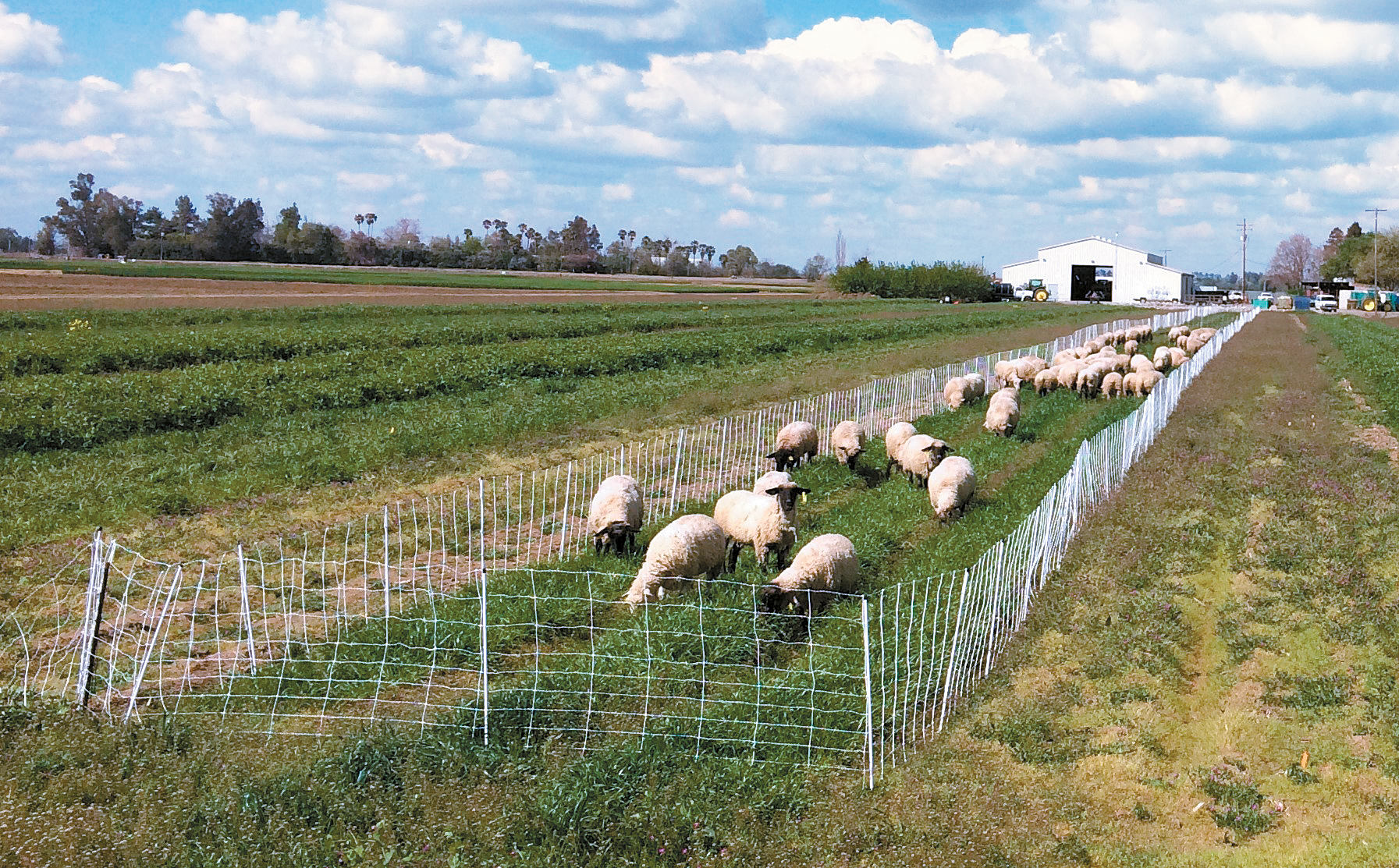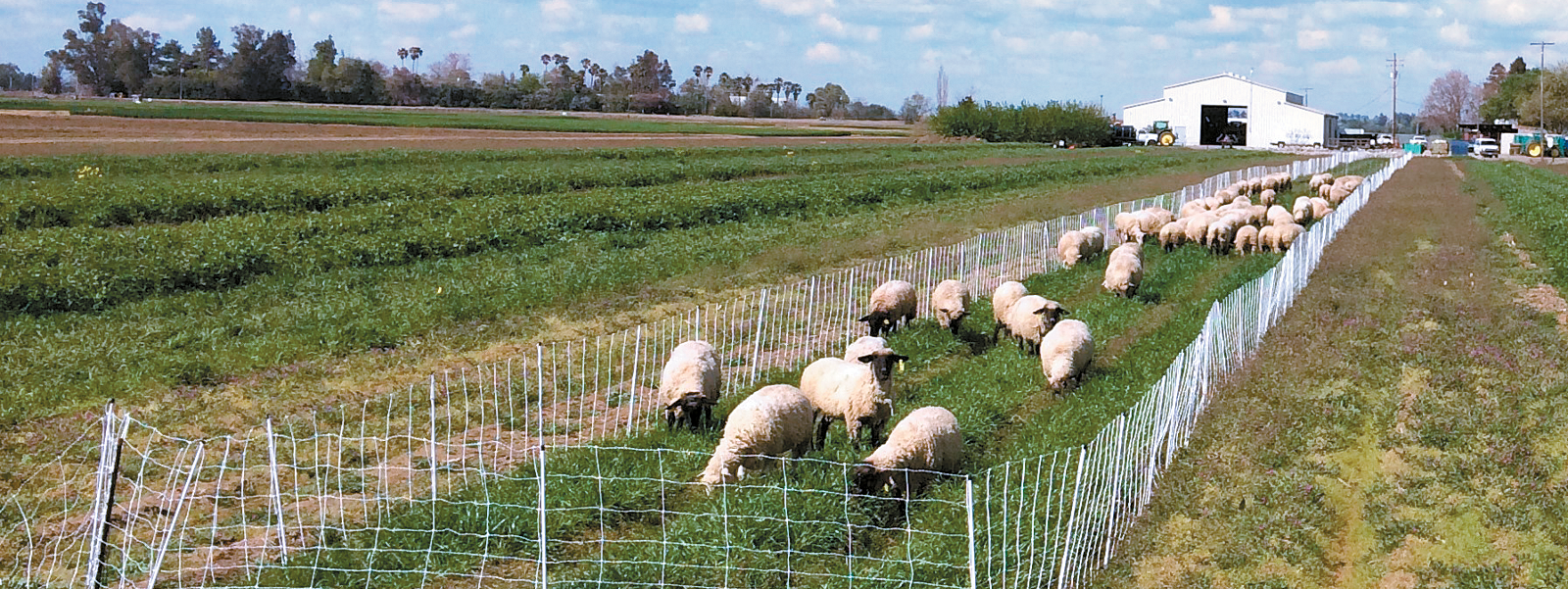Study: Winter grazing of cover crops shows promise

Sheep graze in a test plot of cover crops at the University of California, Davis, Russell Ranch. Researchers say grazing helped soil health and controlled weeds prior to planting summer crops.
Photo/Courtesy Sequoia Williams

.png)
Photo/Courtesy Daniel Macon
By John Watson
Winter grazing of cover crops can provide increased plant-available nitrogen and reduced weed pressure, according to findings of a four-year University of California, Davis, study.
The study examined potential impacts and benefits of sheep foraging in winter cover crops, which were followed by different cash-crop plantings of maize, tomatoes, spinach and cucumbers over four consecutive summers.
Grazing doesn’t add total nitrogen or other nutrients to the system. But it does have the benefit of returning nitrogen to the soil in the form of urine, which quickly transforms into nitrates, a simpler form of the nitrogen molecule that plants can absorb much more readily than the organic nitrogen found in cover crops.
Those were conclusions outlined by Sequoia Williams, a lead author in the study, at a UC Cooperative Extension grazing workshop held in Placer County in October.
With grazing of cover crops, Williams said, timing of nitrate release can be improved, with release more likely to take place at an optimal time for plant intake than ungrazed cover crops.
In the study, the emergence of barnyard grass, a summer weed, was suppressed, as was the prevalence of fungi in the soil, suggesting that grazing has impacts on ecosystem diversity at macro and micro scales.
“Additionally, we didn’t see any negative outcomes of grazing on the soil’s physical health,” said Williams, who oversaw research each winter from 2019 through 2022. “Aggregation and compaction weren’t altered, and nitrate leaching wasn’t significantly higher.”
At the time of the study, Williams was a UC Davis graduate student in the Gaudin Agroecology Lab. She is now a UCCE research and extension technician based in Placer County.
For the study, titled “Soil Health Outcomes in an Annual Integrated Crop-Livestock System in California,” three treatments were set up over four winters at the university’s 300-acre Russell Ranch: fallow, ungrazed cover crop and grazed cover crop, the latter using a herd of sheep.
In all three treatments, investigators measured soil for enzyme activity, soil compaction, food-borne pathogens, nitrate leaching, labile nitrogen and labile carbon. Labile substances refer to compounds that are easily transformed. Researchers also measured total soil carbon and nitrogen.
Although there were no shifts in total soil carbon or nitrogen with grazing, grazed cover-crop plots tended to have greater nitrogen availability for the cash crop across all four years, even resulting in higher yields for the spinach crop.
The sheep, which were provided by the UC Davis sheep barn, were a mixture of Dorset, Suffolk/Hampshire crosses and Dorset/Southdown crosses that were 1 to 5 years old.
“Grazing is not a short-term fix,” said Dan Macon, a UCCE livestock and natural resources advisor for Placer, Nevada, Sutter and Yuba counties who led the grazing workshop. “It’s a longer-term, systematic investment in improving soil health. Just one or two years of grazing is by no means going to solve all of a farmer’s problems.”
In general, he said, well-managed grazing can increase nitrogen cycling and plant activity, increase microbial activity, decrease weed pressure, and reduce reliance on fossil fuels and herbicides. Farmers must always be on the lookout and monitor for soil compaction, nitrate leaching, food-safety risk and logistical complexity, among other concerns.
Williams stressed that each case is unique and that best practices are specific to individual farms. “Positive outcomes from grazing are facilitated by experimenting on farmers’ own sites, first on a smaller, trial scale, learning from mistakes along the way, and then scaling up from there.”
The half-day “Grazing in Cropping Systems Workshop,” which took place at Foothill Roots Farm in Meadow Vista, featured a Q&A with local grazing contractors. All emphasized the need to build farmer-contractor relationships over time so that mutual expectations are successfully communicated.
Examples offered of poorly communicated expectations included an orchard owner who mistakenly assumed that grazing would create a smooth, clean floor, only to later discover he needed to have shared that goal with contractors well in advance.
“If the farmer needs a clear floor, then livestock isn’t appropriate to begin with,” Macon said. “No livestock can graze to bare ground without being severely stressed.”
Standard species options include ruminants such as cattle, sheep and goats, along with monogastrics, including pigs and poultry. The livestock most often used for grazing in crop systems is sheep.
While the farmer’s goal largely determines the type of livestock to be used, animal diet is an important consideration. Macon said generally sheep prefer half grass and half broadleaf plants; goats prefer 20% grass and 80% broadleaf; and cattle prefer 80% grass and 20% broadleaf.
“However, there’s as much difference between individual animals as there is between species,” Macon said. “Animals eat what they’re taught by their mothers, and their forage habits can even develop in embryo, based on the diets their mothers are eating.”
The U.S. Department of Agriculture has rules on wait times between applying uncomposted manure and harvesting.
For instance, for organic farms, National Organic Program regulations require a 90-day wait for crops in which the edible portions don’t come in contact with the soil and at least 120 days for crops in which the edible portions do come in contact with the soil. Some farmers apply these wait times for grazing and the disposition of manure, although the practices are not explicitly covered by the regulations.
The rules may be found at www.ams.usda.gov/rules-regulations/organic/handbook/5006.
(John Watson is a reporter in Nevada County. He may be contacted at john.watson@comcast.net.)




